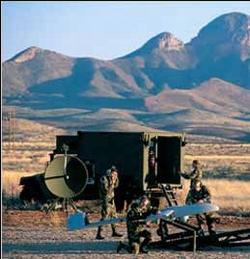Weapons Systems Can No Longer Be Designed For "Niche
Capability"
Future U.S. military weapons are going to have to be relevant,
adaptable and affordable, the nation's second highest-ranking
military officer told defense contractors here today.

Gone are the days of spending millions of dollars on technology
and equipment that is all but obsolete by the time it is fielded to
troops, Marine Gen. James E. Cartwright, the vice chairman of the
Joint Chiefs of Staff, said at the annual Association of the United
States Army.
And no longer can the United States afford to cut out large
chunks of its defense budget for weapons systems that provide only
a niche capability, he said.
The prolonged wars in Iraq and Afghanistan have fundamentally
changed the construct of the force that for decades was built on
the idea of having to fight two large enemies at the same time.
"[Iraq and Afghanistan were] not on anybody's list as peer
competitors. Not on anybody's list to last more than 30 days in
conflict. And here we are now approaching the ninth and 10th year
[at war]," Cartwright said.
Now, weapons systems are going to have to be adaptable enough to
fight across several fronts, and cheap enough to be fielded in
large numbers, he said.
As an example, Cartwright cited the unmanned aerial vehicles now
in high demand in combat. During the Cold War, air superiority was
paramount in defense spending, but the large, costly fighter jets
and bombers have proven less effective in today's counterinsurgency
fight. "Compared to a fixed-wing aircraft ... [a UAV] takes about a
tenth of the gas for about 10 times the flight time. It's always
there when you need it," Cartwright said. "It does incredible
things and has incredible leverage for nowhere near the cost."

Cartwright said he has not yet met a commander on the ground who
doesn't want more of the unmanned aircraft. In fact, the aircraft
cannot be produced fast enough in the United States to fill the
demand overseas, he said. "We're trying to figure out how to open
more [production lines]," he said.
Because of the speed of today's technological advancements, the
general said that any system built has to be flexible enough to
incorporate the latest technology. Cartwright heralded recent
progress made in tying old and new networks together for a broader
missile defense shield, making the system more adaptable. The
system can now tie into radars that were built in the 1970s, he
said. And newer command and control systems are able to tap into
these radars, expanding their range and flexibility.
But, no matter how good a weapon system is, it has to be
affordable, Cartwright said. "You can have the world's greatest
idea, [but] without resources, it's an hallucination," he said.
Cartwright predicted minimal growth and tight funds in the
department's future. "The growth that we've had over the last eight
to 10 years is a thing of the past. And so hard decisions are going
to have to be made," Cartwright said.
What worries him, the general said, is that the trend in defense
building is toward developing top-of-the-line products at very
large costs. Cartwright cited the escalating costs of building
today's bombers. The department bought more than 700 of the B-52
Stratofortress, a long-range bomber used by the Air Force since
1955. They cost about $53 million each in 1998 dollars, according
to the Air Force. The B-1B Lancer bomber was introduced in October
1986 costing more than $283 million each in 1998 dollars. The
Department bought about 100 of them, Cartwright said. The newest
most advanced bomber, the B-2 Spirit introduced to the service in
April 1997, cost nearly $1.16 billion. The department stopped
production at 20. "I can't afford one [plane] on each coast, one
ship on each coast, because that's all I can afford," Cartwright
said. "Think about the next generation bomber. We need hundreds of
them. Not two," he said.

Cartwright said the value of the niche capabilities of a weapons
system have to be weighed against the value of having more
capabilities. "Competition has got to find us a way to get to
scale," he said. "If we don't, we're going to be sorely
disadvantaged. We've got to find a way to get this affordability
equation to work in our favor," he said.
FMI: www.jcs.mil
 Classic Aero-TV: The Switchblade Flying Car FLIES!
Classic Aero-TV: The Switchblade Flying Car FLIES! ANN FAQ: Q&A 101
ANN FAQ: Q&A 101 ANN's Daily Aero-Term (04.12.24): Discrete Code
ANN's Daily Aero-Term (04.12.24): Discrete Code ANN's Daily Aero-Term (04.13.24): Beyond Visual Line Of Sight (BVLOS)
ANN's Daily Aero-Term (04.13.24): Beyond Visual Line Of Sight (BVLOS) ANN's Daily Aero-Linx (04.13.24)
ANN's Daily Aero-Linx (04.13.24)





